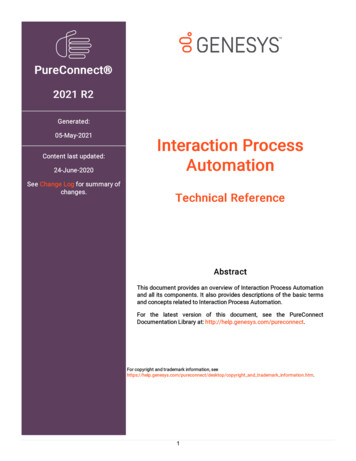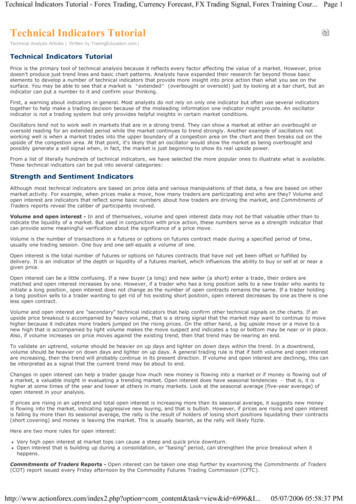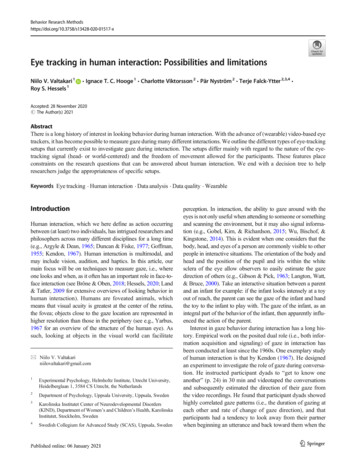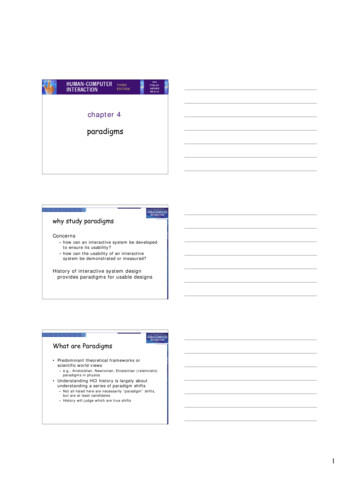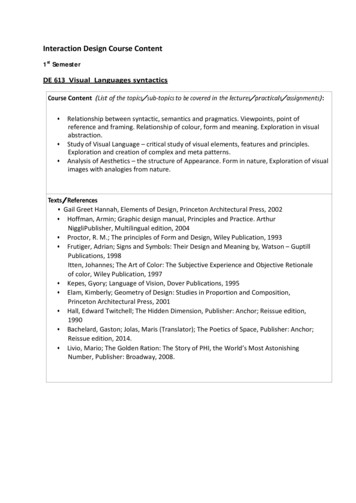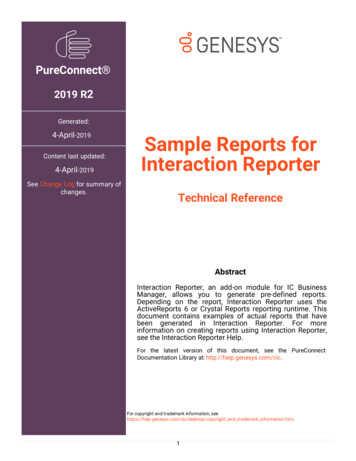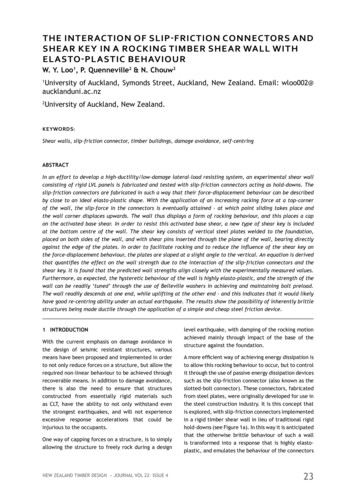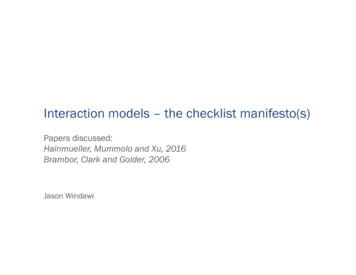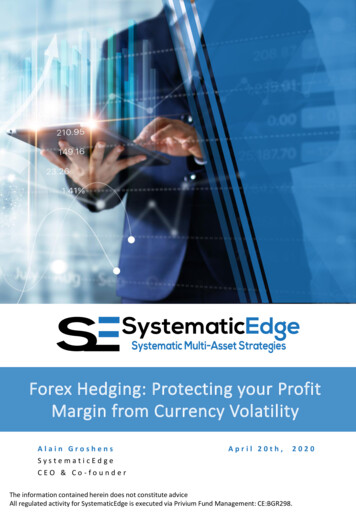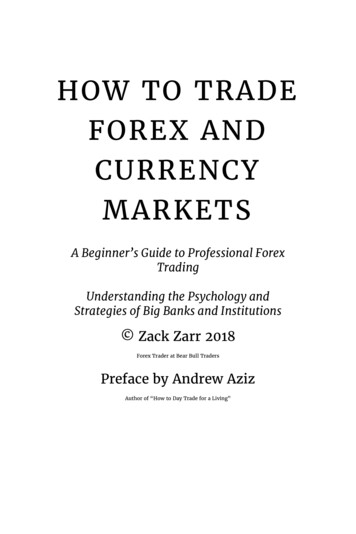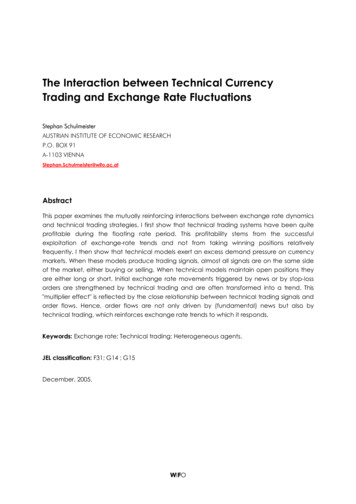
Transcription
The Interaction between Technical CurrencyTrading and Exchange Rate FluctuationsStephan SchulmeisterAUSTRIAN INSTITUTE OF ECONOMIC RESEARCHP.O. BOX 91A-1103 VIENNAStephan.Schulmeister@wifo.ac.atAbstractThis paper examines the mutually reinforcing interactions between exchange rate dynamicsand technical trading strategies. I first show that technical trading systems have been quiteprofitable during the floating rate period. This profitability stems from the successfulexploitation of exchange-rate trends and not from taking winning positions relativelyfrequently. I then show that technical models exert an excess demand pressure on currencymarkets. When these models produce trading signals, almost all signals are on the same sideof the market, either buying or selling. When technical models maintain open positions theyare either long or short. Initial exchange rate movements triggered by news or by stop-lossorders are strengthened by technical trading and are often transformed into a trend. This"multiplier effect" is reflected by the close relationship between technical trading signals andorder flows. Hence, order flows are not only driven by (fundamental) news but also bytechnical trading, which reinforces exchange rate trends to which it responds.Keywords: Exchange rate; Technical trading; Heterogeneous agents.JEL classification: F31; G14 ; G15December, 2005.WIFO
– 1 –Stephan SchulmeisterThe Interaction between Technical CurrencyTrading and Exchange Rate Fluctuations 1.IntroductionTrading techniques based on technical analysis are widely used in financial markets. This isparticularly true for the currency markets as surveys reveal. Roughly 90% of marketparticipants base their trading at least in part on technical analysis, and between 30% and40% of professionals use technical analysis as their most important trading technique.Moreover, the importance of technical analysis has increased more strongly over the 1990sthan other trading practices like the orientation on fundamentals or on customer orders.1)Studies on the profitability of technical currency trading cannot fully explain the extent of thepopularity of technical rules in practice. Although these studies find technical trading systemsto be profitable when tested in sample, they also find the out-of-sample performance to besignificantly worse. Moreover, some studies find that the profitability of trading rules based ondaily data has declined over time (e. g., Marsh, 2000; LeBaron, 2002; Ohlson, 2004). Theevidence on technical currency trading based on intraday data is mixed.2)In the first part of this study, I show which properties of technical trading systems account fortheir popularity among currency traders. The analysis is based on the performance of 1024moving average and momentum models in the single most active foreign exchange market,the DM/ market between 1973 and 1999. An out-of-sample test of the performance of all1024 models between 2000 and 2004 (euro/US dollar) completes this part of the study. Themain results are as follows: The author appreciates valuable comments from William Brock, Ramo Gencay, Charles Goodhart, David Hirshleifer,Cars Hommes, Lukas Menkhoff, Chris Neely and Carol Osler. Special thanks go to Michael Goldberg for (almost)endless discussions, to Eva Sokoll for statistical (and other) assistance and to Markus Fulmek for writing the program fortesting technical trading systems. Financial assistance from the Anniversary Fund of the Österreichische Nationalbank(Austrian National Bank) is gratefully acknowledged (Project 7966).1) For survey studies see Group of Thirty, 1985; Taylor-Allen, 1992; Menkhoff, 1997 and 1998; Lui-Mole, 1998; CheungChinn-Marsh, 2004; Cheung-Wong, 2000; Cheung-Chinn, 2001; Oberlechner, 2001; Gehrig-Menkhoff; 2004, 2005A and2005B.2) For profitability studies based on daily data see Sweeny, 1986; Schulmeister, 1988; Levich-Thomas, 1993;Menkhoff-Schlumberger, 1995; Neely-Weller-Dittmar, 1997; Chang-Osler, 1999; Neely-Weller, 1999; Gencay, 1999;LeBaron, 1999; Osler, 2000; Maillet-Michel, 2000; Ohlson, 2004. Gencay-Ballocchi-Dacarogna-Olsen-Pictet (2002),Dempster-Jones (2002) and Gencay-Dacarogna-Olsen-Pictet (2003) find currency trading based on intraday data tobe profitable, Curcio-Goodhart-Guillaume-Payne (1997) and Neely-Weller (2003) arrive at the opposite result.An excellent survey of all types of studies on technical analysis in different asset markets is Park-Irwin (2004).WIFO
– 2 – Each of these models would have been profitable over the entire sample period, 91.7%would have remained profitable between 2000 and 2004. The number of profitable trades is lower than the number of unprofitable trades. The average return per day during profitable positions is smaller than the average lossper day during unprofitable positions. Profitable positions last 3 to 5 times longer than unprofitable positions. Hence, the overallprofitability of technical currency trading is exclusively due to the exploitation ofpersistent exchange rate trends.In the second (and main) part of the study, I focus on the interaction between the tradingbehavior of 1024 technical models and exchange rate dynamics. In particular, I investigatethe concentration of transactions on buys/sells and of open positions on long/short, and theirimpact on subsequent exchange rate movements. There are several motivations for such aninvestigation.First, the predictive power of aggregate trading signals of different models helps individualactors to form expectations about the expectations and transactions of other actors and,hence, to tackle Keynes’ "beauty contest" problem. An analysis of the impact of aggregatetransactions on subsequent exchange rate movements will help to explain the omnipresenceof technical analysis on the screens in trading rooms (even traders who do not followtechnical signals continuously monitor the most popular models or chart techniques).Second, such an analysis can also shed light on the causes of two characteristics inexchange rate dynamics. The first property concerns the trending behavior of the exchangerate over the long run (Engel-Hamilton, 1990), as well as over the short run (Dewachter, 2001;Neely-Dueker; 2005). The second property concerns the phenomenon of price cascades incurrency markets (Osler, 2003 and 2005) and the general relationship between technicaltrading and exchange rate volatility (Jeanne-Rose, 2002; Bauer-Herz, 2005).Third, an investigation into the feed-back mechanism between exchange rate movementsand technical trading signals contributes to a better understanding of the transmissionprocess from customer demand via order flow to exchange rates. Proponents of themicrostructure approach hold that order flows are only driven by new (still private)information on fundamentals (Evans-Lyons, 2002; 2005A, 2005B, 2005C). However, to theextent that news impact on exchange rates, they do also cause technical models toproduce a sequence of buy or sell signals which in turn induce additional order flows (theextant literature on news has neglected the multiplier effect of technical trading systems).Finally, an analysis of the interaction between the aggregate trading behavior of technicalmodels and exchange rate dynamics provides some empirical underpinning for agent-basedmodels. These computational and theoretically oriented models analyze the interactionWIFO
– 3 –between heterogeneous actors in asset markets, in particular between rational traders andnoise traders.3)The main results of the second part of the study are as follows: Most of the time the great majority of the 1024 models imply positions on the same side ofthe market, either long or short. In response to a new exchange rate trend, technicalmodels change their open positions gradually within 10 to 20 trading days. There operates a strong feedback mechanism between exchange rate movements andthe transactions triggered by technical models. When a certain portion of these modelschange their open positions then the exchange rate changes much stronger than onaverage in the direction congruent with the models’ transactions. After a certain portion of technical models has reversed open positions the exchangerate continues to move in the same direction. This holds also true for exchange ratechanges following days when 97.5% of the models hold already the same – long or short– position. Initial exchange rate movements triggered by news or by stop-loss orders arestrengthened by technical trading and are often transformed into a trend. This "multipliereffect" is reflected by the close relationship between technical trading signals and orderflows.2.The performance of technical currency tradingTechnical analysis tries to derive profitable buy and sell signals by isolating upward anddownward price trends from oscillations around a stable level, called "whipsaws" (for anintroduction into technical analysis see Neely, 1997; for a comprehensive treatment seeKaufman, 1987; Murphy, 1986).The quantitative approaches try to identify trends using statistical transformations of pastprices. These models produce clearly defined buy and sell signals. The most common tradingsystems are moving average models and momentum models.The first type of model consists of a short-term moving average (MAS) and a long-termmoving average (MAL) of past prices. The length of MAS usually varies between 1 day (theoriginal price series) and 8 days, that of MAL between 10 and 30 days. The trading rule of thebasic version of moving average models is as follows: Buy (go long) when the short-term) LeBaron, 2006, and Hommes, 2006, provide excellent surveys on these models in asset markets. The mostcomprehensive study of this type on the foreign exchange market is De Grauwe-Grimaldi, 2006. The price impact ofmoving average rules is specifically analyzed by Chiarella-He-Hommes (2005). Osler (2006) develops amicrostructure-consistent exchange rate model based on the interaction between financial and commercialagents. Frydman-Goldberg (2006) analyze expectations formations and transaction behavior of bulls and bears incurrency markets under imperfect knowledge.3WIFO
– 4 –(faster) moving average crosses the long-term (slower) moving average from below and sell(go short) when the converse occurs.The second type of model works with the difference between the current price and thati days ago (M(i) Pt - Pt-i). The trading rule of the basic version of momentum models is asfollows: Buy (go long) when the momentum M(i) turns from negative into positive and sell (goshort) in the opposite case.Price oscillations often cause technical models to produce "wrong" signals. In order to filterthem out the following rule can be applied: Execute a signal only if it remains valid over nconsecutive days.In the following I summarize some results of a comprehensive study on the components of theprofitability of technical trading systems in the DM/dollar and in the euro/dollar marketbetween 1973 and 2004 (Schulmeister, 2005). The study comprises the following models. In thecase of moving average models all combinations of a short-term moving average (MAS)between 1 and 15 days and a long-term moving average (MAL) between 5 and 40 days aretested (474 models). In the case of momentum models the time span i runs from 3 to 40 days(38 models).Each model is simulated with and without a lag of signal execution by one day (delay filter).Hence, a total of 1024 different technical trading models are analyzed. 4)The gross rate of return (GRR) of any technical trading model can be split into sixcomponents, the number of profitable/unprofitable positions (NPP/NPL), the average returnper day during profitable/unprofitable positions (DRP/DRL), and the average duration ofprofitable/unprofitable positions (DPP/DPL). The following relationship holds:GRR NPP*DRL*DPP – NPL*DRL*DPLThe riskiness of blindly following a technical trading model is estimated by testing the mean ofthe single rates of return against zero (only if it is negative does the trading rule produce anoverall loss).Over the entire sample period all 1024 trading systems produce an annual gross rate of returnof 7.9% on average, their t-statistic amounts to 3.5 on average (table 1). A t-statistic greaterthan 4.0 is achieved by 18.2% of all models, the average rate of return per year (GRR) overthese models amounts to 9.8%. The t-statistic of 38.7% of all models lies between 3.5 and 4.0(GRR: 8.3%), 27.1% generate a t-statistic between 3.0 and 3.5% (GRR: 7.2%). The worstperforming models, (t-statistic 3) with a share of 16.0%, still produce an average return of 5.7%per year.4) The selection of the models, the calculation of their profitability, the role of transaction costs and of the interestdifferential and the estimation of the riskiness of technical trading are documented in Schulmeister (2005). Theexchange rates used are mid rates at noon in New York as published by the Federal Reserve Bank of New st).WIFO
– 5 –Table 1: Components of the profitability of trading systems by types of modelsMoving average and momentum modelsDM/dollar-trading 1973-1999t-statistic ofthe Mean ofthe singlereturns1Number ofmodelsAbsolute Sharein %Mean for each class of modelsGrossrateofreturnt-statisticProfitable positionsUnprofitable tion Numberin daysperyearDurationin days 3.016416.05.692.6165.820.06556.917.26 0.08820.713.0 - 3.527827.17.213.2965.230.06363.266.73 0.08320.583.5 - 4.039638.78.343.7175.990.06953.837.84 0.09215.89 4.018618.29.834.2897.160.07543.5411.19 0.10610.05All models1,024100.07.883.5305.970.06855.018.05 0.09116.872000-20041)All 610.12 0.11613.24) Euro/dollar trading.Technical models have the following pattern of profitability in common (table 1): The number of profitable trades is lower than the number of unprofitable trades.
Trading techniques based on technical analysis are widely used in financial markets. This is particularly true for the currency markets as surveys reveal. Roughly 90% of market participants base their trading at least in part on technical analysis, and between 30% and 40% of professionals use technical analysis as their most important trading technique. Moreover, the importance of technical .
